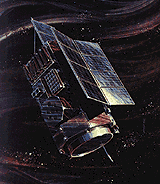HEAO 1, 2, 3
High Energy Astronomical Observatory
 The 3 satellites of the High Energy Astronomical Observatory program surveyed the celestial sphere for X-ray sources and gamma and cosmic ray phenomena. HEAO 1 was primarily a survey mission, dedicated to systematically mapping the X-ray sky every 6 months. HEAO 1 performed almost 3 full celestial surveys and discovered 1500 new X-ray sources. HEAO 2 (also named Einstein) was the world's first orbiting imaging X-ray telescope and returned detailed quasar images and discovered that Jupiter and Earth emit X-rays. The satellite also made over 5,000 targeted observations and discovered several thousand "serendipitous" sources that fell within the field of view of its imaging instruments. HEAO-3 was designed to detect cosmic ray particles and gamma-ray photons to further the understanding of the strength and extent of interstellar magnetic fields, the distribution of interstellar matter, and the stellar nucleosynthesis process which has created the heavy elements contained in
most ordinary matter. All three of the High Energy Astronomy Observatories were regarded as highly successful. The total cost of the program was about $250 million. HEAO 1 reentered 3/15/79, HEAO 2 reentered 3/25/82, and HEAO 3 reentered 12/7/81. (HEAO 1 shown in picture)
The 3 satellites of the High Energy Astronomical Observatory program surveyed the celestial sphere for X-ray sources and gamma and cosmic ray phenomena. HEAO 1 was primarily a survey mission, dedicated to systematically mapping the X-ray sky every 6 months. HEAO 1 performed almost 3 full celestial surveys and discovered 1500 new X-ray sources. HEAO 2 (also named Einstein) was the world's first orbiting imaging X-ray telescope and returned detailed quasar images and discovered that Jupiter and Earth emit X-rays. The satellite also made over 5,000 targeted observations and discovered several thousand "serendipitous" sources that fell within the field of view of its imaging instruments. HEAO-3 was designed to detect cosmic ray particles and gamma-ray photons to further the understanding of the strength and extent of interstellar magnetic fields, the distribution of interstellar matter, and the stellar nucleosynthesis process which has created the heavy elements contained in
most ordinary matter. All three of the High Energy Astronomy Observatories were regarded as highly successful. The total cost of the program was about $250 million. HEAO 1 reentered 3/15/79, HEAO 2 reentered 3/25/82, and HEAO 3 reentered 12/7/81. (HEAO 1 shown in picture)
Spacecraft
3-axis stabilized. Fixed solar panels generate 600 watts. NiCd batteries (24 AHr). Aluminum
honeycomb structure. Passive thermal control. Hydrazine propulsion (240 lbm fuel) with 6 dual thrusters. S-Band communications using omni antennas. Attitude control system provided arcminute pointing accuracy and arcsecond attitude determination.
Payload
HEAO 1: Carried four instruments. A1 - Large Area Sky Survey experiment (LASS) - covered the energy range 0.25 to 25.0 keV; A2 - Cosmic X-ray Experiment (CXE) - designed to study the large scale structure of the galaxy and the universe, yielding high quality spatial and spectral data over the energy range 2-60 keV; A3 - Modulation Collimator (MC) - designed to measure positions of X-ray sources with sufficient precision to identify optical and/or radio counterparts; A4 - Hard X-Ray / Low Energy Gamma Ray Experiment.
HEAO 2: X-ray telescope sensitive over the approximate energy range 0.2-3.5 keV. The telescope focused energy on one of four instruments: High Resolution Imaging (HRI) - a digital X-ray camera which provided high spatial and temporal resolution in the 0.15-3.0 keV energy range; Imaging Proportional Counter (IPC) - a position sensitive proportional counter sensitive between 0.4-4.0 keV; Solid State Spectrometer (SSS) - a cryogenically cooled lithium-drifted Si(Li) detector with a range between 0.5-4.5 keV; Bragg crystal spectrometer (FPCS). It also carried the Monitor Proportional Counter (MPC), which monitored the 1-20 keV X-ray flux of the source(s) being observed by the telescope, as well as a Broad Band Filter (BBFS) spectrometer and an Objective
Grating Spectrometer (OGS).
HEAO 3: Gamma ray spectrometer with 4 cryogenically cooled germanium detectors, each with an energy range of 50 keV to 10 MeV.
| Country of Origin | United States |
| Customer/User | NASA, MSFC |
| Size | Approx. 9 m long x 3.6 m diam. |
| Orbit | 1: 428 x 447 km 22.7 deg / 2: 520 x 541 km 23.5 deg / 3: 485 x 501 km 43.6 deg |
| Design Life | 1: 6 months / 2: 1 year / 3: 1 year |
Launch Facts
| Name | Int'l Desig. | Date | Site | Vehicle | Orbit | Mass(kg) |
| Notes | ||||||
| HEAO 1 | 1977-075A | 8/12/77 | ESMC | Atlas Centaur | LEO | 2720 |
| High Energy Astronomical Observatory; surveyed sky in X-ray band | ||||||
| HEAO 2 | 1978-103A | 11/13/78 | ESMC | Atlas Centaur | LEO | 3150 |
| High Energy Astronomy Observatory | ||||||
| HEAO 3 | 1979-082A | 9/20/79 | ESMC | Atlas Centaur | LEO | 3150 |
| High Energy Astronomy Observatory; cosmic, gamma ray measurements | ||||||
Information in The Mission and Spacecraft Library is provided without warranty or guarantee. USE AT YOUR OWN RISK.